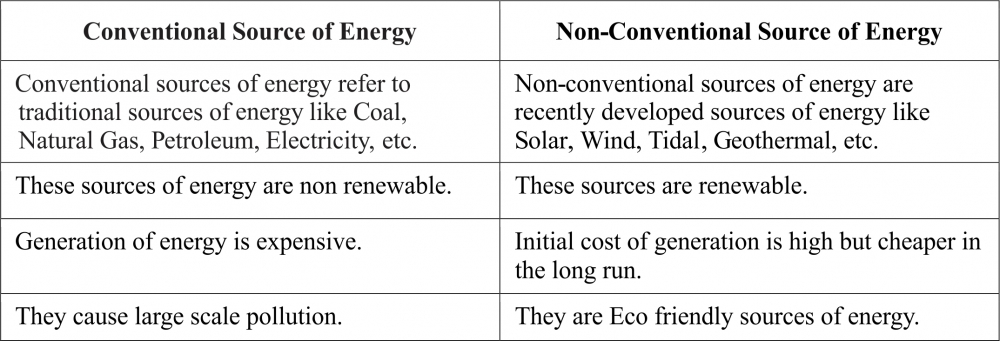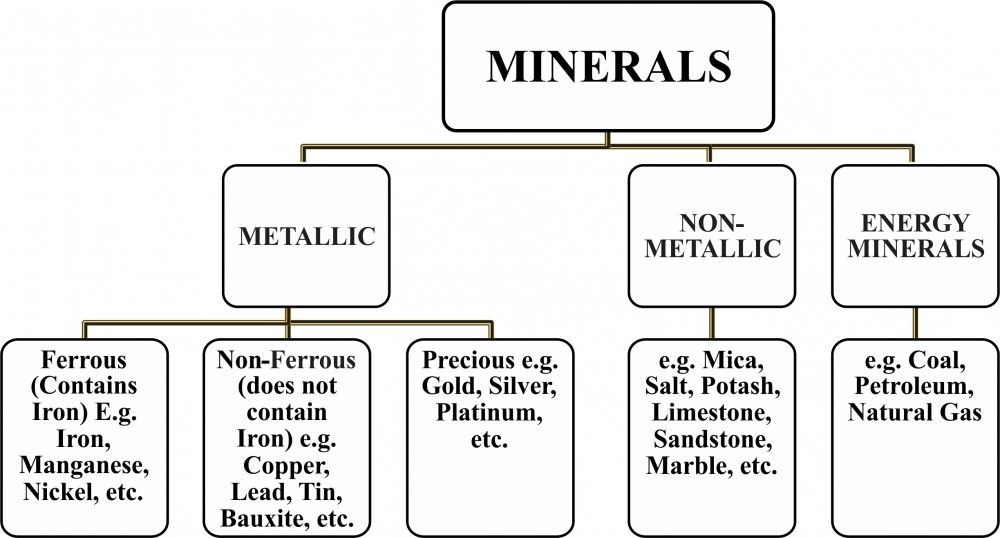Class X: Chapter 5 (Minerals and Energy Resources) Question & Answers
Q1. What is a mineral?
Ans: A homogenous, naturally occurring substance with definable internal structure is called mineral.
Q2. What are the properties of minerals?
Ans: Following are the properties of minerals:
(a) Minerals are unevenly distributed throughout the world.
(b) Minerals take millions of year to form and are present in impure form.
(c) Minerals are non-renewable 'exhaustible' resources.
Q3. Mention the varieties of coal found in India.
Ans: Following are the different varieties of coal found in India:
(a) Anthracite: This is the highest quality hard coal.
(b) Bituminous: Coal which was formed because of increased temperature and was buried very deep is called bituminous coal. This is the most popular coal for commercial use. High grade bituminous coal is ideal for use in metallurgy.
(c) Lignite: It is a low grade brown coal. It is soft and has high moisture content. Neyveli in Tamil Nadu has the main reserves of lignite coal. This type of coal is used for electricity generation.
Q4. Write a note on Bauxite an ore to Aluminum.
Ans: (a) Bauxite is clay like substance, out of which aluminum is obtained.
(b) Amarkantak Plateau, Maikal hills and the plateau region of Bilaspur-Katni are the main areas of bauxite deposits.
(c) In 2009-10 Orissa was the largest producer of bauxite in India with 34.97%.
(d) Panchpatmali in Koraput district is the most important centre of bauxite deposit in Orissa.
(e) Aluminum is incredibly popular because it is Lightweight, Strong, Durable, Ductile, Malleable, etc.
(f) Aluminum is used in: Automobiles, Aircraft, Spacecraft, Packaging (Cans, Foil, frame, etc). Food and beverage containers, etc.
Q5. Write a note on Geo Thermal Energy.
Ans: Geo thermal energy refers to the heat and electricity produced by using the heat from the interior of the Earth. Geothermal energy exists because; the Earth grows more and more hot with increasing depth. Where the geothermal gradient is high, high temperatures are found at shallow depths. Groundwater in such areas absorbs heat from the rocks and becomes hot. It is so hot that when it rises to the earth's surface, it turns into steam. This steam is used to drive turbines and generate electricity.
There are several hundred hot springs in India, which could be used to generate electricity. Two experimental projects have been set up in India to harness geothermal energy. One is located in the Parvati valley near Manikarn in Himachal Pradesh and the other is located in the Puga Valley, Ladakh.
Q6. Differentiate between Hydro Electricity and Thermal Electricity.
Ans:

Q7. Minerals are essential part of our life, it is important to know about the occurrence of minerals. Mention different modes where minerals occur?
Ans: Minerals are usually found in ores. Minerals generally occur in the following forms:
(a) In Igneous and Metamorphic Rocks: The smaller occurrences are called veins and the larger occurrences are called lodes. They are usually formed when minerals in liquid/molten and gaseous forms are forced upwards through cavities towards the earth's surface. Examples: tin, copper, zinc, lead, etc.
(b) In Sedimentary Rocks: In these rocks, minerals occur in beds or layers. Coal, iron ore, gypsum, potash salt and sodium salt are the minerals found in sedimentary rocks.
(c) By Decomposition of Surface Rocks: Decomposition of surface rocks and removal of soluble constituents leaves a residual mass of weathered material which contains ores. Bauxite is formed in this way.
(d) As Alluvial Deposits: These minerals are found in sands of valley floors and the base of hills. These deposits are called placer deposits. They generally contain those minerals which are not corroded by water. Examples; gold, silver, tin, platinum, etc.
(e) In Ocean Water: Most of the minerals in ocean water are too widely diffused to be of economic importance. But common salt, magnesium and bromine are mainly derived from ocean waters.
Q8. Describe the distribution of iron ore in India.
Ans: Iron ore is the basic mineral and the backbone of industrial development. The major iron ore belts in India are:
(a) Orissa Jharkhand Belt: Badampahar mines in the Mayurbhanj and Kendujhar districts of Orissa have high grade hematite ore. Additionally, hematite iron ore is mined in Gua and Noamundi in Singhbhum district of Jharkhand.
(b) Durg Bastar Chandrapur Belt: This belt lies in Chhattisgarh and Maharashtra. The Bailadila range of hills in the Bastar district of Chhattisgarh have very high grade hematite ore. This hilly range has 14 deposits of super high grade hematite ore. Iron from these mines is exported to Japan and South Korea via Vishakapatnam port.
(c) Bellary Chitradurga Chikmaglur Tumkur Belt: This belt lies in Karnataka. The Kudremukh mines located in the Western Ghats are a 100 percent export unit. The ore from these mines is transported as slurry through a pipeline to a port near Mangalore.
(d) Maharashtra Goa Belt: This belt includes the state of Goa and Ratnagiri district of Maharashtra. The ores in these mines are not of very high quality. They are exported through Marmagao port.
Q9. Differentiate between Conventional and non-conventional sources of energy.
Ans:

Q10. Draw a flow chart to explain the classification of minerals.
Ans:

Q11. On the map of India locate the following:
(A) Iron Ore Mines: Mayurbhanj
(B) Iron Ore Mines: Kudremukh
(C) Bauxite Deposits: The Amarkantak Plateau
(D) Bauxite Deposits: Orissa: Panchpatmali Deposits In Koraput
(E) Mica Mines: Ajmer
(F) Mica Mines: Gaya
(G) Coal Mines: Bokaro
(H) Coal Mines: Neyvali
(I) Oil Fields: Digboi
(J) Oil Fields: Mumbai High
(K) Thermal Power Plant: Ramagundam
(L) Thermal Power Plant: Tuticorin
(M) Nuclear Power Plant: Rawat Bhata
(N) Nuclear Power Plant: Kalpakkam
Ans:
_0_o.jpg)
-----x-----X-----x-----

There are no published comments.
New comment